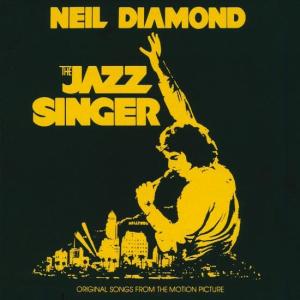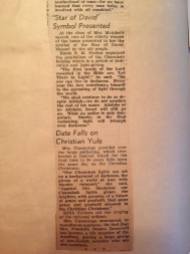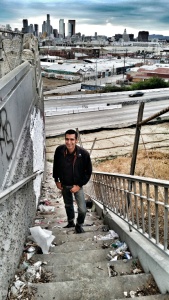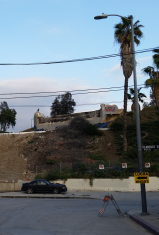How the Jewish and Latino Communities Resolved Conflict in Post-War Boyle Heights (1940s-1950s)
How can we revolve conflict and prevent violence in our changing eastside communities? What can we learn from history regarding this? What should the community keep in mind as we see the demographics changing here once again? What should we consider as we see an uneasy integration taking place here?

Voter registration, during the historic 1948 voter drive in which 15,000 new voters from the barrios were registered by the efforts of the Community Service Organization (CSO). This is what really provided the democratic muscle to help Edward Roybal, our first Mexican-American local representative, get elected to the LA City Council. The CSO received its essential funding and mentoring in organizing from Saul Alinsky, and his Industrial Areas Foundation, under the guidance of his local representative Fred Ross Sr. (see photo,far left). As well as financial support directly from the local Jewish Community Relations Committee (CRC), today known as the Jewish Federation of Greater Los Angeles.
The reality is that this type of turbulent change, it has happened all before. Community change being met with racial conflicts and classist fears, this has all come around before.
However, it’s important to remember that the people of this community have a profound history of forging inter-community partnerships to conquer prejudice and racial tension.
This was especially true in the late-1940s through the mid-1950s, in the partnerships between the shrinking Jewish community of the area and the growing Mexican American community of Boyle Heights, East Los Angeles.
Recently when discussing notable history of the area I had talked with people a lot about the cooperation of Jews and the minority community in the fight against the Nazi fascism during the 1930s and through the 1940s. Of the Jewish and non-sectarian organizations which they founded to fight fascism, and how many went on to be essential backers of minority empowered organizations in the fight against Jim Crow segregation. [see “The Anti-Nazi Parade, Boyle Heights 1938: How Our Multi-Ethnic Community Responded to the Jewish Refugee Crisis.”]
During the years leading up to and then through World War II many Jewish people and minorities had a lot in common still, because the nature of prejudice and the persistence of segregation in that age. In those days their partnerships were essential and seemed quite natural.
Though I believe that history clearly shows us that the partnerships between Jews and Latinos becomes most interesting in the post-war years. Though sadly, most people write off the history of the Jewish eastside after the war. During a time when such partnerships could be considered counterintuitive to many.
The reality is that telling the story of inter-community relations becomes much more complicated after the war, so many just avoid it at all cost. As Jews and Latinos begin to have less in common with each other, which does result in increased friction. Frictions which were not uncommon before the war, and the specter of which fearfully hung over the Jewish community with even greater concern following the war.
In the decade following the wartime riots, the general population was genuinely afraid of a resurgence of this violence in the form of race riots. The larger population was fearful of Mexican American residents taking vengeance on them after the events of the so-called Zoot Suit Riots, wartime riots in which white sailors and citizens committed vigilante violence against Chicanos; so for several years already the public was expecting an eminent explosion of Mexican American rage in the form of riots.
So what did the Jewish leaders of the area do post-war to resolve racial conflict and prevent violence in the changing community? How did they overcome the issues of having to deal with the communal bitterness felt by the growing racial minority groups regarding housing and job market inequity? How did Jews react with even being perceived as exploiters and absentee landlords controlling these older neighborhoods?
The fact is scapegoating of Jews in the eastside has existed as far back as any of us remember. And it is something that the Jewish community out of necessity realized they had to address more assertively when they found themselves in the role of being the smaller minority here after the war.
We need to more honestly tell the story of the communal challenges of that era. Instead of avoiding the hard truths which culminate at this point in history. We need to recognize the reality that even in the “good old days” of the historic interracial community of Boyle Heights of yesteryear which many are prone to idealize today, even then the established community of Jews of the area had to put a great deal of work and invest a lot of money into dispelling racism, classism, antisemitism and preventing misdirected violence.
The reality is that inter-cultural and inter-faith respect of classic Boyle Heights was not just a given. Living next to people of other races and cultures, it did not necessarily integrate people to one another, nor effortlessly create mixing and understanding.
Again, it took real effort and true intention to accomplish this sense of community cohesion with a diverse population of residents here. Which begs me to ask: So why is it that today people expect it to just happen all by itself? Why is the current establishment of our community federations really doing nothing to support direct inter-community cooperation and inter-racial socialization? How is that today they do not see fit to really contribute anything to mitigate a long history of tensions which are revisiting us here?
I dare say that my fellow community, cultural, religious and interfaith leaders of today really need to learn some pages from our local history. And reflect on how to help our community of today resolve the currently rising tensions, in tried and true ways.
I ask us to consider these selected pages of history here:
“RESOLVING CONFLICT, PREVENTING VIOLENCE”
from Bridges of Reform: Interracial Civil Rights Activism in Twentieth-Century
By Shana Bernstein
The Zoot Suit Riots’ legacy factored prominently into postwar calculations about the value of cooperating across community divides, especially as the mounting housing crunch and employment discrimination escalated racial tensions in minority areas. As tensions threatened Angelenos’ safety, they stirred Jews’ and Mexicans’ — along with the rest of Los Angeles’ fears that violence would once again erupt in their city. The American Council on Race Relations’ 1945 study titled The Problem of Violence: Observations on Race Conflict in Los Angeles: explained: “There was general apprehension on the part of many who had seen the evidences of friction increasing and apparently cumulating, who had lived through the ‘zoot-suit’ riots.” These people, the study reported, “feared that post-war Los Angeles with its restricted employment opportunities for Negroes and Mexicans, its wretchedly inadequate housing facilities and its greatly increased population would become a battle ground on which Americans battled each other.” The threat of violence forced Angelenos to realize that wartime attempts to improve race relations in the city had fallen short.
Sometimes the tensions and competition for resources did result in violence, both between whites and minorities and among minority groups. Much of the violence was perpetrated against minorities, especially African and Mexican Americans, by whites….
[pg. 151-152; continuing selection with, pg. 154-156.]

These were the terrible living conditions of the Mexican families, living in the settlements of Fickett Hollow, Boyle Heights. (1950)
East Los Angeles Jewish and Mexican community, among whom relations were particularly strained as the two groups’ financial, social, and geographic distance increased, viewed potential violence as an especially salient issue. As Jews in Los Angeles, as elsewhere, confronted housing restrictions and employment discrimination, they, unlike Mexican Americans, also made economic strides, became increasingly integrated, and gradually moved toward the more affluent west side. The Mexican origin population, on the other hand, was “Southern California’s largest and, in many ways, most disadvantaged minority,” according to a 1949 report by Alinsky’s Industrial Areas Foundation. The group’s poverty, lack of networks to other communities, low voter turnout, and high percentage of non-citizens, according, to reports like these, impeded attempts at securing financial backing to pressure politicians to improve their conditions. A 1946 investigation of racial minorities’ conditions by the ACRR concluded that the Mexican-American community was in even more dire straits other than poor Los Angeles minorities.
Increasingly different class status distanced Jewish and Mexican Americans from one another. In the schools, the ACRR’s report The Problem of Violence observed, “The great barrier to the acceptance of Mexican children by Jewish children is the middle-class bias of the Jewish parents expressed in excessive concern over dirt and disease.” Divergent police actions towards the two groups also, it explained, served to “contribute to the increase of community tensions between middle-class Jews and lower-class Mexicans. The “class bias” was intertwined with a racial bias, too, as Jewish Americans were becoming increasingly integrated into American society and accepted as white, while Mexicans increasingly faced categorization as brown “others.”
Mexican-Americans saw their Jewish neighbors moving to nicer neighborhoods while their own conditions stagnated or deteriorated, breeding “frustration and bitterness.” Alinsky’s Industrial Area’s Foundation reported, “These, in tern, found expression in intergroup hostility and scape-goating with particular reference on the Eastside to the adjacent Jewish community.” Jews who moved west frequently kept east side businesses and retail properties, which sometimes provoked charges of exploitation from their former neighbors. Associating Jews with exploitation stemmed in some cases from anti-Semitic assumptions, since many non-Jews also became absentee landlords.
This growing divide between two communities that seemingly had little in common after the war counter intuitively helps explain their interest in collaboration. Because Mexican Americans’ daily struggle for survival left little money to fund organizations such as the CSO, they sought support from other Los Angeles ethnic communities, including Jews. The Jewish community’s motives for assisting a group increasingly distant from its own population seem less apparent. CRC [the Community Relations Committee of the Jewish community; the predecessor to the Jewish Federation of Greater Los Angeles] leaders, discussing the Mexican, American community, justified support for the CSO by explaining that it “deflects the hostility which exists in that community against the Jews, to constructive social issues of benefit to the Mexican-American and the Jew alike.” The CSO could “by its very existence, prevent race riots such as have happened before in this city.” CRC leaders claimed it already had “no doubt prevented serious repercussions which might have otherwise happened on the East Side.” CRC executive director Herzberg countered a member’s protest that the CRC should stop funding the CSO, since it was not “closely related enough to the activities of the Jewish community,” by explaining that its “prophylactic value” was “a relatively cheap investment” for the Jewish community. Herzberg’s comment that the CSO would help prevent “gang fights and similar anti-social acts” also reveals underlying assumptions about Mexican Americans’ violent potential. Fears of violence also shaped Jewish community interest in the African-American community. The CRC reported Jewish concern about the implications of demographic transformations in the Watts neighborhood, specifically the increasing African-American and Mexican-American populations. Mounting unemployment created a situation of “increasing problems of social relations” that “could be explosive as far as the Jewish community is concerned.” Many of the retail stores on the main street of Watts were owned and run by Jews, it reported, explaining that the year before, “a vigorous anti-Semitic campaign” arose as unemployed residents demonstrated their frustration about limited job opportunities. The report also identified mounting tensions between the African-American and Mexican-American communities in the neighborhood. In response to such tensions, the CRC expressed to the director of planning of the City Planning Commission that it was “deeply concerned about some of the conditions of living in the Watts area of our city.”

A colony on Fickett St. showing a number of bungalows built in a canyon in Boyle Heights. This was one of the poorest barrios, which impoverished Mexicans were relegated to; out of sight and concern to even people of good conscience.
Amidst these complex attitudes, which reflect some degree of prejudice and misunderstanding of each other, both Mexican-American and Jewish-American communities viewed bridge-building projects as critical for their mutual survival. The CSO particularly hoped to secure Jews’ participation since, as Ross explained, “this is the other large group on the East Side and Jewish-Mexican American relations have left a good deal to be desired for some time.” Ross attempted to obtain Jewish community support by emphasizing to the CRC how the CSO’S work improved “deplorable” East Los Angeles neighborhood conditions that “had been reflected in a history of hostility between Spanish speaking colonies and the Jewish Community surrounding the Jewish Community surrounding Temple Street.” The CSO reported in 1949 that two years of efforts had redirected the “scape-goating” of nearby “disadvantaged groups” (specifically the “adjacent” Jews) and had “pav[ed the way] for cooperation with other groups particularly with those in the Jewish Community.”
In short, memories of World War II-era violence and fears of its recurrence helped inspire postwar collaboration. In cases like the CSO, such fears even resulted in important new postwar civil rights initiatives which continued the earlier thrust of reform and demonstrate the continuity between 1935 and World War II era collaboration and its later Cold War incarnation.
In a previous post I actually went into great detail about the CSO, when talking about the connection between the early garment worker’s movement of the 1930s-1940s, and the rise of the CSO in 1940s-1950s, and the continuity of these social justice aims which eventually gave rise to the United Farm Workers in the 1950s-1960s.
However, I think it is import to revisit some of this important chapter in history:
The Importance of the Community Service Organization (CSO)
The historic influence of the Community Service Organization (CSO) in Latino civil rights and politics cannot be overstated.
Founded in 1947 in the Los Angeles eastside, CSO was envisioned by Fred Ross Sr., while inspired and funded greatly by Saul Alinsky. As well as later receiving essential financial backing from allied Jewish organizations – most notably the Community Relations Committee (CRC) – a Jewish organization founded originally in the early 1930s as an anti-fascist organization; dedicated to fighting antisemitism, pro-Nazi outreach and organized racism. [it would later become know as the Jewish Federation of Greater Los Angeles; also see, “Jewish Federation Council of Greater Los Angeles. Community Relations Committee (1933-), Special Collections & Archives”]
The Community Service Organization (CSO) was uniquely created to be a “Mexican NAACP.” Ross and Alinsky took notice that Mexicans were by far the largest and yet most ill-treated minority. Mexicans still being the only minority group to not be widely organized. And also standing alone in having no political power or decision-making, with less than 10% of Latino citizens being registered to vote. [see “The Color of America Has Changed: How Racial Diversity Shaped Civil Rights.”]
In the words of Scott Washburn of CSO:
“In 1947, in direct response to rampant police abuse, a lack of educational opportunities, widespread discrimination in government services, a strong culture of bigotry that allowed even people of good conscience to turn a blind eye to the suffering of their neighbors, and ultimately, to the Zoot Suit Riots and Bloody Christmas, the Community Service Organization was founded by Antonio Rios, Edward Roybal, and Fred Ross, Sr. Quickly, the CSO became a training ground for the first generation of Latino leaders, including Cesar Chavez, Dolores Huerta, and Gilbert Padilla. Recognizing the need for a unified Latino voice and for some semblance of political representation, the CSO initially concentrated on organizing voter registration drives in Latino communities all across California. In 1949, the CSO’s efforts culminated in the election of Edward Roybal, the first Latino to serve on the Los Angeles City Council.”
 Royball would ride a wave of crucial Yiddish speaking political support in Boyle Heights, backing his ascent to City Hall and further still. The future Congressman Edward Royball would later take his social causes to the halls of the US Congress with him as well.
Royball would ride a wave of crucial Yiddish speaking political support in Boyle Heights, backing his ascent to City Hall and further still. The future Congressman Edward Royball would later take his social causes to the halls of the US Congress with him as well.
Fred Ross would continue to expand CSO at the behest of Alinsky, helping establish their presence first in Oxnard and later in San Jose. Cesar Chavez and Dolores Huerta, trained by CSO in Alinsky style protest, would then take the cause directly into the local fields; thus founding the United Farm Workers, which is widely considered the most influential and visible Latino organization to date. The UFW is the primary historical and still active model for Latino activism to this day.
[Learn more about the discipleship of Cesar Chavez under the tutelage of Saul Alinsky, and the rise UFW as an outgrowth of CSO. See “Cesar Chavez: Autobiography of La Causa.”]
Again, historian Shana Bernstein notes:
“While the CSO is represented as a Mexican-American activist group in much Chicano scholarship, it was an interracial endeavor from its very beginning and its membership was diverse well into the 1950s. The grassroots CSO drew its main support from a combination of older Mexican-American activist groups who had participated in the 1930s-era movement and newer ones who emerged out of the war as veterans. It also received significant support from other Angelenos, most importantly Jewish Americans. Its early organizers encouraged multiracial membership. “Although they great majority of CSO members are Mexican-Americans, we have gradually had members of other groups come in,” Ross Reported of its 1948 meetings. “At the last meeting, for instance, we had 15 reps from the adjacent Jewish community, 4 Negros and around 18 so called ‘Protestant Anglos’” In 1949 Ross reported to the CRC that “Orientals, Negroes, Jews and Christians” compose the approximately 12 percent of membership that was not Spanish-speaking. In the early to mid-1950s, the organization’s chairman Tony Rios reported that 15 percent of its more than 3,500 members (approximately 3,000 from three L.A. County branches and 500 from San Jose) were “from the Negro, Jewish, and the so-called Anglo-American communities.”
The contributions in civil rights organizing which began here in Boyle Heights with inter-racial cooperation in establishing the CSO, it would bear fruit even beyond this community. Inspiring the pursuit of even larger gains of empowerment of working-class Mexican-Americans. Though it was a multi-ethnic endeavor. And their achievements of this era, they were attributed to their inter-community cooperation.
Interracial Programming of the Eastside Jewish Community Centers
While Bernstein and I tend to often focus on the labor and political organizing history of this area, it is very important to note the more well known cultural and social activities which contributed to better race relations and for strengthening community cohesion.
The eastside Jewish Community Centers most notably provided programming for all of the community; it was open to Jewish and non-Jewish people alike. Indeed as much as 15% of the members of the Soto-Michigan Jewish Community Center were not Jewish, as well as about 3% membership of the more Orthodox Religious Zionist-based Menorah Center in City Terrace. While these centers offered programming for the members of the local Jewish community, they also sought to meet the needs of all their neighbors as well.

“Students arrive for after-school activities at the Eastside Jewish Community Center on Soto Street, c. 1950. Formerly the Soto-Michigan Jewish Community Center, the Eastside Jewish Community Center sponsored integrated sporting leagues as well as programs designed to introduce cross-cultural understanding. In the 1950s, center director Joseph Esquith was removed because his policy of keeping the facilities available to anyone, regardless of politics, was considered subversive. (Los Angeles Daily News Photographic Archive, Department for Special Collections, Charles E. Young Research Library, UCLA)”
Though these numbers might seem modest, this did make a major impact in forging the community’s sense of interracial fellowship; offering after-school programs, sports and swimming. In an atmosphere free from the racial segregation which was common in most other neighborhoods and at many public facilities.
After the war, and after the steep decline of the Jewish population of the area in the decade to follow, these Jewish community centers began to refocus their efforts to further bring the causes of the current non-Jewish residents into their walls. And also giving space to socially progressive causes of the area’s working-class immigrants.
As we will further explore, this progressive stance eventually came with major consequence and persecution for the remaining Jewish community leaders here on the eastside. During the McCarthy era Red Scare which was feverishly consumed with the weeding out of communists. In a political atmosphere where promoting socialism, internationalism and labor progressive organizing made many people targets for being labeled communists enemies of the state.
Inevitably, it was their open door policy to people of all backgrounds and political persuasions which would in the end doom these Jewish community centers later on in the 1950s.
To be continued…..
Related articles:
















 So far we have discussed the original
So far we have discussed the original 





















 There is one shocking fact that was kept secret from the public until it was recently revealed by scholars, how from the Nazis headquarter in downtown Los Angeles there where American fascists who were even planning terrorist attacks on the Jewish public. They were plotting to kidnap 20 Jewish Hollywood studio heads and their allies, and execute them in order to kick off an American pogrom. While also planning on going on a terrorist rampage with machine guns, to kill as many people as possible in the densely populated Jewish community of Boyle Heights.
There is one shocking fact that was kept secret from the public until it was recently revealed by scholars, how from the Nazis headquarter in downtown Los Angeles there where American fascists who were even planning terrorist attacks on the Jewish public. They were plotting to kidnap 20 Jewish Hollywood studio heads and their allies, and execute them in order to kick off an American pogrom. While also planning on going on a terrorist rampage with machine guns, to kill as many people as possible in the densely populated Jewish community of Boyle Heights.












 In 1996 director Ellie Kahn premiered a wonderful documentary called “Meet Me at Brooklyn and Soto,” about the old Jewish community of Boyle Heights, East Los Angeles. It is still one of the most well-known and most loved documentaries about the history of the neighborhood.
In 1996 director Ellie Kahn premiered a wonderful documentary called “Meet Me at Brooklyn and Soto,” about the old Jewish community of Boyle Heights, East Los Angeles. It is still one of the most well-known and most loved documentaries about the history of the neighborhood.






























